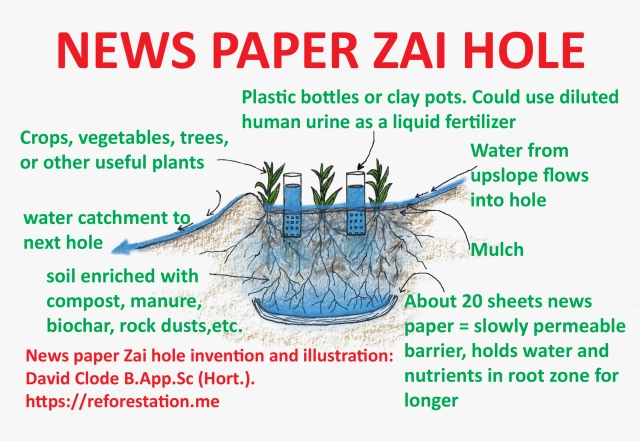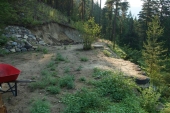




West of Denver, Colorado @ 8,000'
Zone 4(ish)... Summers are still brutal!




Invasive plants are Earth's way of insisting we notice her medicines. Stephen Herrod Buhner
Everyone learns what works by learning what doesn't work. Stephen Herrod Buhner




Anne Miller wrote:I can attest to the fact that the sun shining on rocks creates water.
I know I have placed rocks in pots for drainage.
In "Dry climates - using rocks under beds to help retain water?"
An experiment to prove this would be interesting.
West of Denver, Colorado @ 8,000'
Zone 4(ish)... Summers are still brutal!




 1
1




 6
6





 2
2





Zai hole experiment results 30 July 2019
These experiments compare the yield of three crops in standard Zai holes, and in Newspaper Zai holes, where 20 sheets of newspaper are placed at the bottom of the hole in a bowl shape.
Results show that Zai pits with newspaper at the base of the hole produce more than Zai holes without newspaper at the base of the hole for all three different crops.
...Zai holes generally produce 50% or more (up to 600%) compared to conventional row cropping, and the newspaper Zai holes may produce even more (depending on the crop, soil type, climate etc.)...
...While this experiment has very limited replication, a yield increase of 300% is enormously significant and is considerably more than expected. I double-checked with Salim, and he has confirmed that the only difference is the 20 sheets of newspaper at the base of the Zai hole, and that the watering and fertilizer regimes were the same for all the Zai holes, as well as the environmental conditions. Yields are likely to be different in different soils, climates and crops, either more or less.
It seems likely that the newspaper has concentrated and held water and nutrients in the root zone for longer, but not long enough to cause waterlogging or root rot, while at the same time maintaining optimal soil aeration, all of which have greatly increased plant growth and food yield. Another factor in the success of this technique may be that evenly moist but aerated soil could have promoted the growth of of beneficial soil life such as mycorrhizal fungi (which enhances nutrient and water uptake).






Be joyful, though you have considered all the facts. ~Wendell Berry














 1
1




![Filename: sunken-bed-desert-garden-Aug-2022.jpg
Description: Long sunken desert hugel/zai pit beds [Thumbnail for sunken-bed-desert-garden-Aug-2022.jpg]](/t/190852/a/189017/sunken-bed-desert-garden-Aug-2022.jpg)
![Filename: sunken-bed-after-a-monsoon-rain.jpg
Description: Desert hugel sunken bed filled with water shortly after planting - all the seeds stayed in place and still came up! [Thumbnail for sunken-bed-after-a-monsoon-rain.jpg]](/t/190852/a/189018/sunken-bed-after-a-monsoon-rain.jpg)
![Filename: trellis-gardening-in-desert-to-create-shade-and-retain-moisture.jpg
Description: A desert hugel sunken bed garden with trellis for added growing area, shade and wind protection. Creates a microclimate underneath. [Thumbnail for trellis-gardening-in-desert-to-create-shade-and-retain-moisture.jpg]](/t/190852/a/189019/trellis-gardening-in-desert-to-create-shade-and-retain-moisture.jpg)
Be joyful, though you have considered all the facts. ~Wendell Berry










 1
1




Be joyful, though you have considered all the facts. ~Wendell Berry

| I agree. Here's the link: http://stoves2.com |





